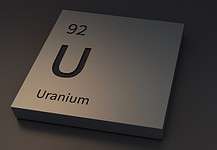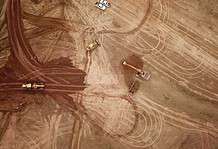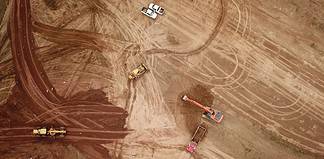
The thermal coal company caters to a niche market, with around 65 per cent of its production exported to Asia-Pacific customers including Japan, Korea and Chile. The remainder is consumed by customers
in southeast Queensland. New Hope has been active in the Ipswich area of southeast Queensland since 1952, with several of its current investors having held shares in the company since the early 1970s.
New Hope acquired its flagship project, Acland, in December 1999. It comprises the New Acland mine, which was fast-tracked to achieve first commissioning in October 2002, and a number of other deposits and exploration targets.
Since then, New Hope has maintained a focus on its Australian interests and has sold off its overseas investments in order to concentrate solely on projects at home. According to the company’s website, New Hope’s competitive advantages include vertical integration and control of each step in the coal chain – from the exploration and mining of coal through to delivery to customers. New Hope is unique in that it
ships its coal through the company’s wholly-owned ship-loading facility at the Port of Brisbane. The QBH facility is a common-user terminal that has been used for loading coal by New Hope and other producers since 1983. The terminal has a capacity of 10 million tonnes per annum and is a critical part of New Hope’s mine-to-customer coal chain strategy.
New Hope exports Tivoli brand coal: a thermal (or steaming) coal that has a high calorific value, and which provides excellent combustion and environmental performance in electricity generation. The coal
produces low nitrous oxides and carbon dioxide emissions, and is low in sulphur. According to New Hope, this makes it one of Australia’s cleanest burning coals.
In the half year ended January, New Hope experienced higher coal production and export rates – driving a 25 per cent increase in its first half net profit. After tax this figure stood at $101.1 million.
The company reported that for the half year ended January 31 2012, 4.27mt of its coal was loaded through its QBH terminal – a significant increase compared to 3.46mt for the January half year in 2011, and 6.52mt for the full year ended July 2011. Not for sale In October 2011, New Hope announced to the ASX that it had received a number of preliminary proposals from third parties in relation to potential change of control transactions. As a result it launched a formal process for potential bidders, allowing selected parties to submit proposals to the board for consideration. “The board believes that New Hope has a unique suite of assets with significant strategic value. New Hope has a very large reserve and resource base, it has a significant development pipeline and it is a low-cost producer with access to infrastructure,” New Hope chairman Robert Millner said in the announcement. “However, it is the duty of the board to consider legitimate opportunities for the company which may be in the best interests of all shareholders. A formal process will allow the board to assess these opportunities in a considered manner, with minimal disruption to New Hope’s day-to-day business activities.”
Up until the end of February, a number of third parties had been undertaking due diligence on New Hope. However, the company reported on March 1 that none of the discussions with interested parties had produced a definitive proposal reflecting New Hope’s value and growth. It therefore decided to terminate the process and instead focus on its own strategy to grow the company and increase shareholder value. The company reported that it had confidence in its robust development pipeline and in the ability of management to deliver on this strategy.
Acland Coal mining has been a mainstay in the Acland area, west of Brisbane in the Darling Downs region of Queensland, since 1913. In fact, the township was largely established around the development of several underground mines.
New Hope commissioned the New Acland mine in 2002, and by 2008 had begun operating Stage 2. The New Acland mine currently produces at a rate of 4.8mtpa of saleable coal. The coal is open cut mined with trucks, excavators and front-end loaders, then processed and transported to customers.
New Hope reported in a statement in late March that it was progressing plans to double the company’s coal production during the next five to seven years, subject to government approvals and regulations. Part of this strategy is the New Acland Project, a proposed third stage of the New Acland mine. New Acland Project The third stage proposes to increase New Acland production by up to 10mtpa and extend the mine life by about 30 years. The project will include a land management program conducted by Acland Pastoral Company, which will ensure mining lease areas are returned to agricultural and conservation use as quickly as possible once they are no longer being utilised for mining purposes.
The expansion will progressively develop three areas (Manning Vale, Willeroo and Sabine) within Mining Licence Application 50232. The application covers 5069 hectares; if approved, Stage 3 will increase the
Acland lease area to 7347ha. The Queensland Government gave the proposed Stage 3 expansion ‘Project of State Significance’ status, which required the submission of an Environmental Impact Statement
(EIS). The EIS was lodged with the Department of Infrastructure and Planning in August 2008. Following an initial review, an amended EIS was lodged in late 2009. New Hope received public comments until
February 2010, and has lodged a Supplementary EIS (SEIS) in response. Final SEIS documentationis now being compiled, including advanced impact assessment studies for the area around the Jondaryan
rail-loading facility.
In addition to the land management program, the New Acland Project also aims to preserve items of historical and cultural significance in the Acland area. As such, New Hope will establish an Acland Heritage Precinct for the care and display of such items. In continuing its community-focussed vision, New Hope will employ locals wherever possible for Stage 3. Currently, 280 people are directly employed at the New Acland mine with 80 per cent of the workforce originating from the region.
The Stage 3 expansion will create an additional 250 jobs during peak operation, as well as 180 indirect positions in the area, and 800 indirect roles in support and supply. New Hope reported that during the
quarter ended January, drilling for the Stage 3 project included 18 chip holes for 2424m, aimed at confirming locations for infrastructure. Additionally, 12 core and 14 chip holes were drilled at the Acland mine
to increase confidence in coal quality and define the location of intrusives. The company said in the quarterly report that the SEIS for Stage 3 would be submitted to the Office of the Co-ordinator General in April. It also said that alternative mine design and infrastructure studies were under way, and that further community consultation had been undertaken.
By Rachel Dally-Watkins











































